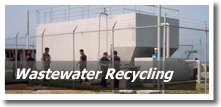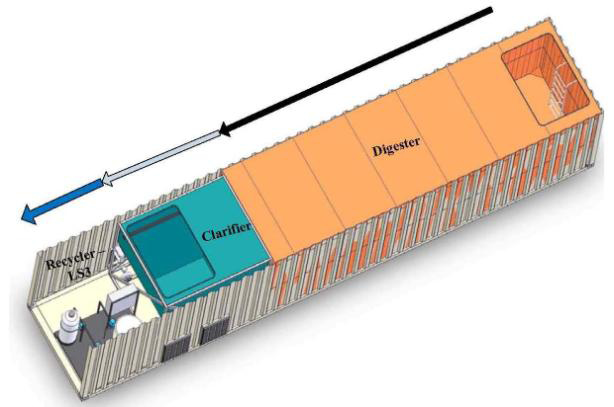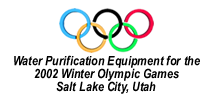| Wastewater Processing
& Wastewater Effluent Recycling | WWR
System Construction & Operation | FAQ
| Examples | Municipal
System Clusters
WWR-M2.5K Collage | Building
EWWRU-M20K | WWR Cost Sheet
 WWR
SYSTEM CONSTRUCTION & OPERATION WWR
SYSTEM CONSTRUCTION & OPERATION
UNIT CONSTRUCTION AND OPERATION - GENERAL OVERVIEW
(Patent Pending)
The GLOBAL WASTEWATER-RECYCLING SYSTEM utilizes the extended aeration
method of sewage treatment. Five separate operations are involved
in this process.
 The
first operation is a coarse screening process. The
first operation is a coarse screening process.
As the influent enters the sewage treatment unit, it passes through
a BAR SCREEN . The bar screen will catch any large trash such as
rags, plastic bags, etc., and prevent it from entering the system.
[In existing, conventional facilities, Global utilizes whatever
pre-screening and/or separating equipment that is useable, as the
basic quote includes delivery from the city to the Global system.
However, when necessary, Global will replace screeners, pre-filters,
grinders and pumps. Also, the first operation may include a surge
tank to control abnormal influent flow rates.]
The second operation is aeration.
As the sewage passes through the bar screen, it flows into the
AERATION CHAMBER . The aeration chamber is the largest component
of the sewage treatment system, and is usually sized to provide
a 12-hour retention time for the daily average flow volume of sewage.
In the aeration chamber, the incoming raw sewage is mixed with water
that contains a large concentration of very active aerobic bacteria
that consume the organic waste material in the sewage. Air flowing
up through the liquid from the DIFFUSER keeps the bacteria in suspension,
and also provides the necessary amount of oxygen required by the
bacteria for their respiration and digestion process. The airflow
through the liquid also provides the agitation necessary to keep
solids from settling on the bottom and helps break up solid waste
material in the sewage.
The bacteria in the aeration chamber will stick together in little
flakes of sludge called a biofloc or floc that becomes uniformly
mixed in with the water as a result of the agitation caused by air
flow from the diffusers. This floc cannot be discharged from the
unit, because it is also an organic pollutant. However, it is easy
to physically separate the floc from the water during the treatment
process. This separation process is the third operation.
The third operation consists of
clarification and settling.
After the usual 12-hour average retention time in the aeration
chamber, all liquid is displaced eventually by additional sewage
flowing into the sewage treatment unit. The displaced liquid flows
around a baffle and through an opening into a separate chamber called
the CLARIFIER . The clarifier is volumetrically sized to ensure
solids settling separation from the liquid.
In contrast to the liquid in the aeration chamber, the liquid in
the clarifier is kept as still as possible to allow the sludge to
flocculate and settle to the bottom. This settling process separates
the sludge from the clear liquid flowing downward and upward around
the clarifier baffle. The clear liquid at the top of the clarifier,
outside the clarifier baffle, is also eventually displaced from
the clarifier over a WEIR, disinfected and then discharged.
The sludge or floc that has settled to the bottom of the clarifier
is continuously drawn up by the airlift SLUDGE RETURN line and discharged
back into the aeration chamber.
Any floating material in the liquid flowing into the clarifier
is contained by the CLARIFIER BAFFLE, and then it will be eventually
drawn into the SKIMMER RETURN LINE. The floating material is then
discharged back into the aeration chamber.
Both the skimmer and sludge return lines operate by using air from
the air supply system. The air is injected into both the skimmer
and sludge return lines. As the resulting air bubbles rise, they
displace the liquid in the lines. This displacement develops a suction
at the inlet to each line.
The unit air supply is a critical requirement for unit operation.
If the unit air supply is inadequate, not only will the bacteria
in the aeration chamber die off or become anaerobic, but also the
skimmer and sludge return will stop operating as required. The unit
air supply is provided by a BLOWER SYSTEM incorporated into the
total system.
Inadequate air supply to the aeration chamber diffusers will also
result in the growth of anaerobic bacteria that will release odor-causing
gases.
Thus, air supply control is one of the few constants in maintenance
procedures.
The fourth treatment operation is
the recycling of suspended solids.
The effluent flowing from the clarifier is then placed in a holding
tank for input into the Global Recycling Process. This effluent
will still have suspended solids and high e-coli. GLOBAL’S
LS3-Recycling-Water System (“LS3-RECYCLER”) shall have
a pre-filtration process to separate and collect all suspended solids
(TSS).
The LS3-RECYLER shall pull from the Clarified Holding Tank. This
process shall be automated. The Recycler shall collect all TSS for
backwashing discharge. This discharge should be piped back to the
Aeration Chamber for black-water processing. The backwash system
shall include a backwash tank which shall be automatically re-filled
after backwashing.
The fifth treatment operation is
the water purification process.
The LS3-RECYCLER shall process the effluent through a standard
Global-LS3 Water purification system. The effluent, removed of all
suspended solids down to 10-Microns, will flow through a 5-Micron
filtration and then 1-Micron filtration to remove parasites.
The next process will be through Global’s proprietary multi-media
adsorption and absorption formulation to remove hazardous chemicals.
From there, the effluent passes through an Ultra-Violet (UV) component
to kill bacteria and viruses. The water output shall equal or exceed
all WHO and International-EPA standards.
Wastewater Processing &
Wastewater Effluent Recycling | WWR System
Construction & Operation | FAQ
| Examples | Municipal
System Clusters
WWR-M2.5K Collage | Building
EWWRU-M20K | WWR Cost Sheet |




